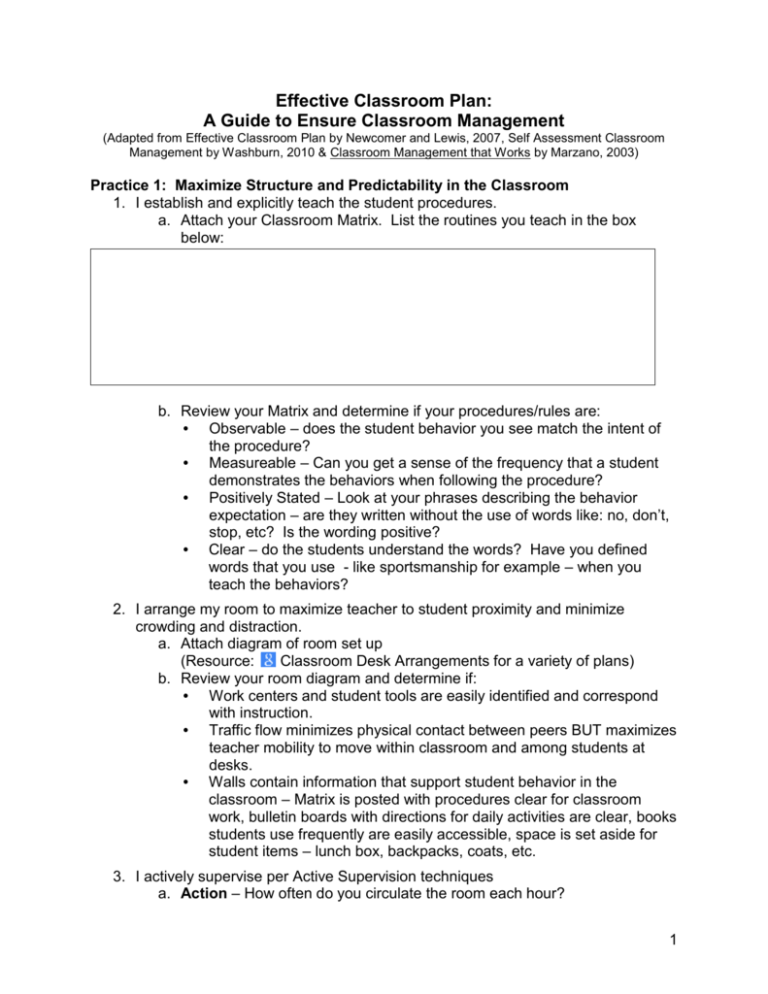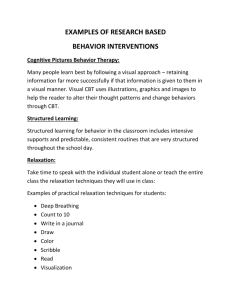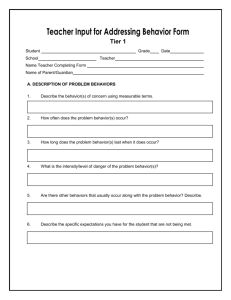Effective Classroom Plan
advertisement

Effective Classroom Plan: A Guide to Ensure Classroom Management (Adapted from Effective Classroom Plan by Newcomer and Lewis, 2007, Self Assessment Classroom Management by Washburn, 2010 & Classroom Management that Works by Marzano, 2003) Practice 1: Maximize Structure and Predictability in the Classroom 1. I establish and explicitly teach the student procedures. a. Attach your Classroom Matrix. List the routines you teach in the box below: b. Review your Matrix and determine if your procedures/rules are: • Observable – does the student behavior you see match the intent of the procedure? • Measureable – Can you get a sense of the frequency that a student demonstrates the behaviors when following the procedure? • Positively Stated – Look at your phrases describing the behavior expectation – are they written without the use of words like: no, don’t, stop, etc? Is the wording positive? • Clear – do the students understand the words? Have you defined words that you use - like sportsmanship for example – when you teach the behaviors? 2. I arrange my room to maximize teacher to student proximity and minimize crowding and distraction. a. Attach diagram of room set up (Resource: Classroom Desk Arrangements for a variety of plans) b. Review your room diagram and determine if: • Work centers and student tools are easily identified and correspond with instruction. • Traffic flow minimizes physical contact between peers BUT maximizes teacher mobility to move within classroom and among students at desks. • Walls contain information that support student behavior in the classroom – Matrix is posted with procedures clear for classroom work, bulletin boards with directions for daily activities are clear, books students use frequently are easily accessible, space is set aside for student items – lunch box, backpacks, coats, etc. 3. I actively supervise per Active Supervision techniques a. Action – How often do you circulate the room each hour? 1 b. Talk – How do you track that you use the 5:1, Positive to Negative ratio in conversation with students? c. Positive Interaction – How do you ensure your comments to students are positive and reinforce positive behaviors when you see those behaviors? d. Scan – When you scan the room – what behaviors are you looking for so that you can reinforce or discourage behaviors? e. Rule Violations are handled quickly and quietly – What do you do to handle rule violations quickly and quietly? Practice 2: Establish, Teach and Positively State Classroom Expectations and Procedures 1. Review your Matrix and directions for classroom work and determine if: a. You use language to communicate what we will “do” in the classroom as opposed to what we “don’t” do. b. I involve students in the refinement of the routines and rules when the offer suggestions that support a positive classroom environment. c. I explicitly teach the procedures on these dates: d. Attach a lesson for teaching rules and procedures. Did you: • Tell students what the procedure is? • Model the procedure or provide students with the procedure to develop skits for? • Have students practice procedure while using positive patter and reinforce the correct actions? • For middle and high school do you have students identify the correct use of the procedure after they critiqued the skit? 2 e. Explain when you determine it is time to reteach the rules and procedures: Practice 3: Managing Behavior Through Effective Instructional Delivery 1. I conduct smooth and efficient transitions between activities. a. Explain the plan that you teach students to ensure smooth/efficient transitions between activities, instruction and movement to/from classroom. 2. Explain how you prepare for lessons/activities (materials readied, clear directions, check for understanding, etc.): 3. How do you provide students with a clear explanation of outcomes or objectives for the lesson: 4. What ways do you provide specific feedback to students at the end of a lesson – or during the lesson: Practice 4: Actively Engage Students in Observable Ways 1. List the strategies and structures you use to provide multiple and varied opportunities for each student to respond during instruction: 2. List the strategies you use to engage students in observable ways during instruction (i.e. response cards, choral response, votes, etc.) 3 3. I frequently check for student understanding by: Practice 4: Evaluate Instruction 1. I know how many students have met the lesson/activity objective in this way: 2. List the ways you provide extra time and instruction for students who struggle: 3. What strategies do you use to consider needed improvements (to lesson/activity) for next time? Practice 6: Maximize Positive Interactions 1. I use these strategies to maintain a ratio of 5:1 positive interactions: 2. I keep track of how often I positively interact with every student at least 2-3 times per hour on average by using these strategies: 3. After correcting rule violations, I use acknowledgement and positive reinforcement for rule following by using these strategies: 4 Practice 7: Use a Continuum of Strategies to Acknowledge Appropriate Behavior 1. I provide specific and immediate contingent acknowledgement for academic and social behaviors to individuals through multiple strategies and actions (specific praise, stickers, notes, etc) a. On a daily basis these are the reinforcers I use: b. On a weekly basis these are the reinforcers I use: c. On a monthly basis these are the reinforcers I use: 2. I provide specific and immediate contingent acknowledgement for academic and social behaviors to the class as a whole through multiple strategies and actions (free time, popcorn party, extra playtime, etc.) a. On a daily basis these are the reinforcers I use: b. On a weekly basis these are the reinforcers I use: c. On a monthly basis these are the reinforcers I use: Practice 8: Use a Continuum of Strategies to Respond to Inappropriate Behavior 1. List the strategies you use to provide specific, contingent and brief error corrections (stating the expected behavior) for academic and social errors. 5 2. Explain how you use the least restrictive procedure to discourage inappropriate behavior (nonverbals, proximity, eye contact, reteaching, etc) 3. Explain how you determine that you need to move to more restrictive procedures and the techniques you use in that type of situation. 4. How has responding to inappropriate behavior in a calm, emotionally objective and business like manner helped you work with students who push limits with their behavior? Practice 9: Developing Caring and Supportive Relationships 1. What is date do you set as your goal to learn student names? 2. What activities do you use to learn about your students? 3. How do you communicate with students and their families - before school and during the school year? 4. How do you describe your communication style with students? What is your communication style when you are correcting student behavior errors? 6 Practice 10: Teach about Responsibility and Provide Opportunities for Students to Contribute to the Good Functioning of the Classroom 1. What activities do you use to encourage and reinforce student responsibility in the classroom? 2. What strategies do you use to help students learn self control and self monitoring behaviors? 3. What activities do you use that allow students to practice social skills instruction and problem solving? 4. What activities do you use to help students get to know one another and solve problems collaboratively? 7 Resource List for the 10 Practices in the Self Assessment Classroom Management Tool Note: Classroom Management that Works: Research Based Strategies for Every Teacher by Robert J. Marzano (ASCD, 2003) is a great resource for more in depth information about every listed practice. 1. Maximize Structure and Predictability in the Classroom Resource: Classroom Desk Arrangements for a variety of plans PBIS Step 5: Develop Procedures for Teaching Classroom Behavior Expectations – Tier 1 Workbook Sample Lesson Plan for Matrix Instruction Active Supervision 2. Establish, Teach and Positively State Classroom Expectations and Procedures PBIS Step 5: Develop Procedures for Teaching Classroom Behavior Expectations – Tier 1 Workbook 3. Managing Behavior Through Effective Instructional Delivery Top 17 Classroom Management Strategies that should be emphasized in every classroom (Lewis 2007) T1 Workbook pgs 71 – 73 4. Actively Engage Students in Observable Ways Kagan Structures from past trainings Total Participation Techniques (Himmele & Himmele, 2011) from past trainings Riverside COE Active Participation Strategies – currently reworking 5. Evaluate Instruction Total Participation Techniques (Himmele & Himmele, 2011), Chapter 8 Top 17 Classroom Management Strategies that should be emphasized in every classroom (Lewis 2007) 6. Maximize Positive Interactions Top 17 Classroom Management Strategies that should be emphasized in every classroom (Lewis 2007) Use of points, stickers, beans in pocket to track positives 10 Demandments 7. Use a Continuum of Strategies to Acknowledge Appropriate Behavior PBIS Step 6: Develop an Continuum of Procedures for Encouraging and Strengthening Use of Schoolwide Behavior Expectation – Tier 1 Workbook Room 13 Sample 10 x 2 Strategy Recognition Ideas 8 8. Use a Continuum of Strategies to Respond to Inappropriate Behavior PBIS Step 7: Develop an Continuum of Procedures for Discouraging Student Behavior Violation – Tier 1 Workbook Room 13 Sample How Should Staff Respond to Minor Problem Behaviors? 5 Strategies: Prompt, Redirect, Reteach, Provide Choice, Conference with Student – Tier 1 Workbook Active Flowchart: ODR A Comparison of Typical Approaches for Addressing Academic and Behavioral Problems 9. Developing Caring and Supportive Relationships Kagan Structures from past trainings Total Participation Techniques (Himmele & Himmele, 2011) from past trainings 10 x 2 How Should Staff Respond to Minor Problem Behaviors? Demeanor: Calm, Consistent, Brief, Immediate, Respectful, Specific - Tier 1 Workbook Strategies from School Parent Engagement work 10. Teach about Responsibility and Provide Opportunities for Students to Contribute to the Good Functioning of the Classroom Character Counts Lessons Values programs Kagan Structures from past trainings Total Participation Techniques (Himmele & Himmele, 2011) from past trainings 9 10




